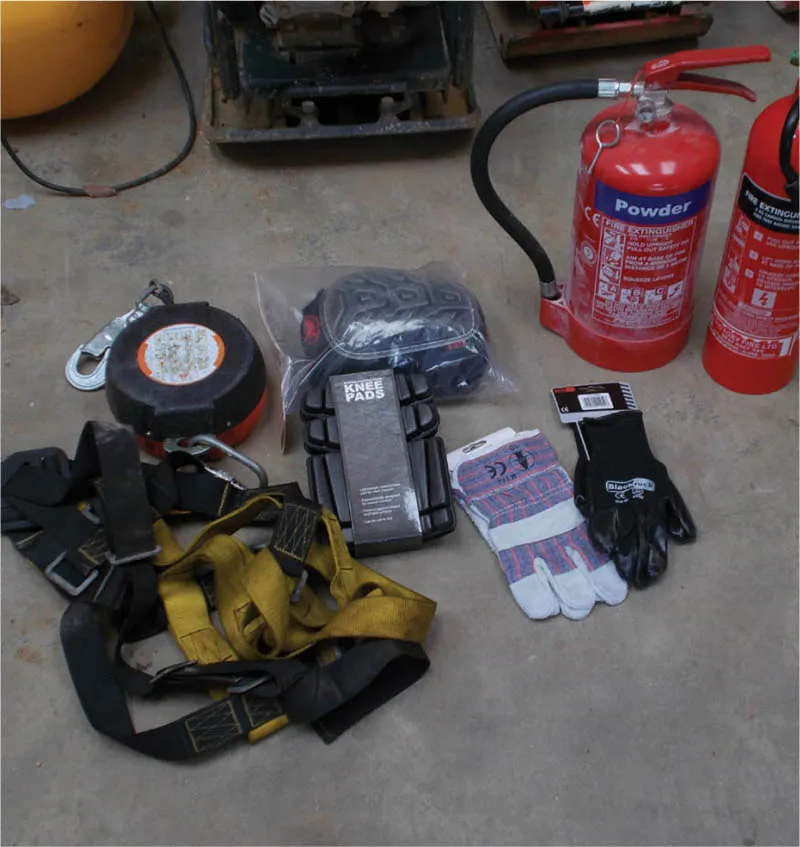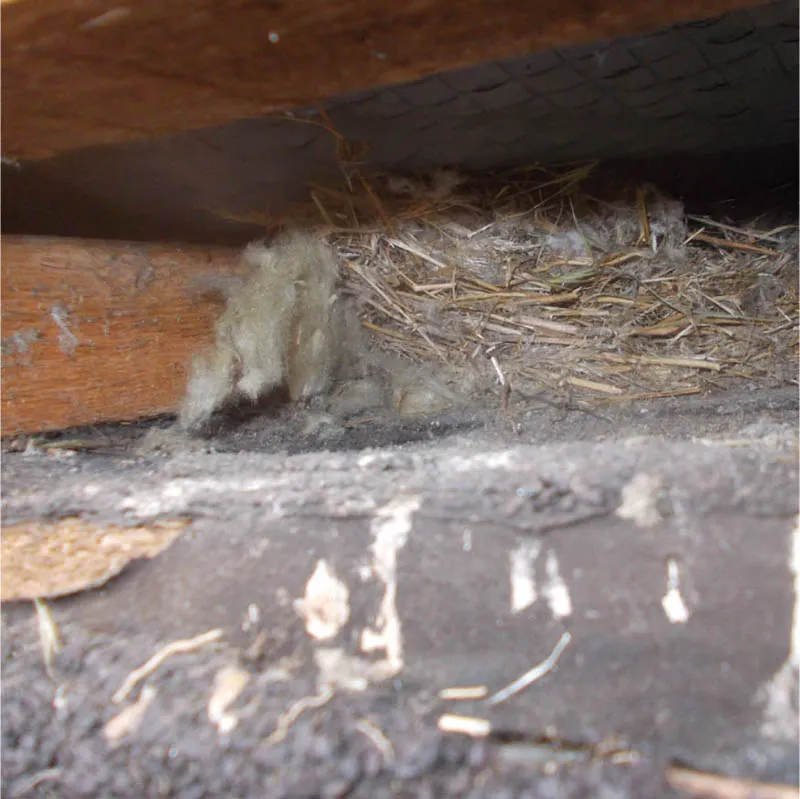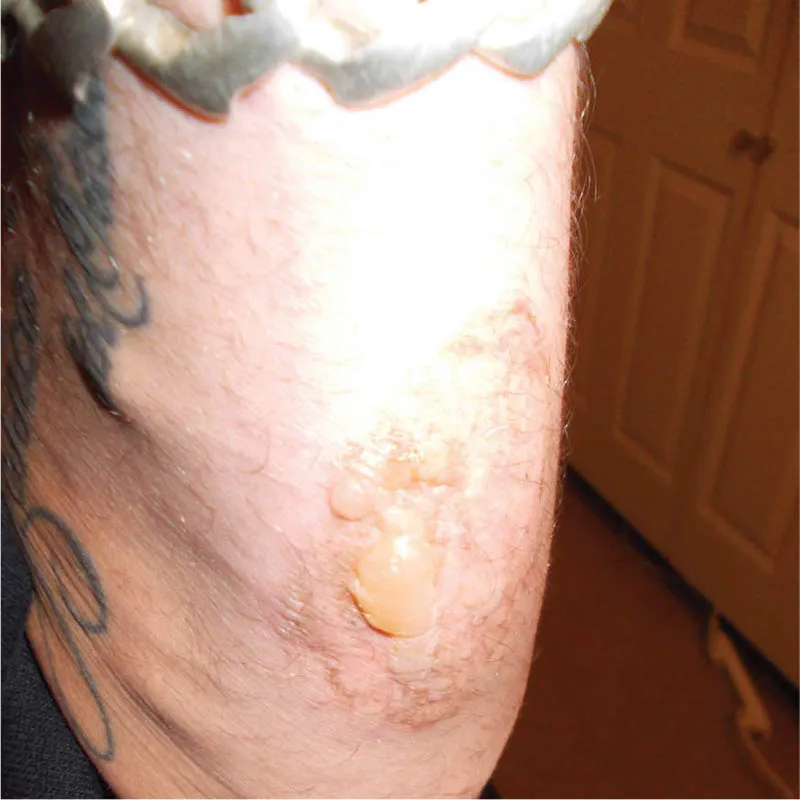![]()
CHAPTER ONE
PREPARATION
HEALTH AND SAFETY
Now I know what many of you are thinking: ‘Here’s the section about fire being hot, the diagram of a knife showing which end is sharp and how not to kill yourself by jumping off a roof.’ In all trades there are standard health and safety issues that are inherent in any type of construction and maintenance jobs. With torch on felt roofing, however, there are not just these standard dangers, but the added hazards which come with working at height, using scalding hot materials and naked flames, so please do take note.
There are so many health and safety regulations, it would not be practical to include them all in this book; this chapter will therefore try to cover the basics. Health and safety regulations have not always been around and contractors have, for the most part, gone home after a day’s work alive and with all limbs intact. That is not to say health and safety regulations are worthless, they have undoubtedly made huge changes to contractors’ welfare. But it does go to show that health and safety regulations alone are useless without contractors using some common sense when working in hazardous situations.
Fire Safety
Always keep access and egress routes clear and always keep a fire extinguisher to hand and accessible at all times. From personal experience, a fire extinguisher that is inaccessible because there is a fire in front of it is not much use to anyone.
A story was printed in the newspapers in September 2012 about a gang of roofers who burnt down two houses while relining concrete gutters. Any hot works should be treated with respect, with precautionary measures being put in place before work commences. Above all, an appropriate fire extinguisher should be purchased or hired to prevent this situation occurring. CO2 extinguishers are often the best, although not the cheapest choice for torch on felting. Powder extinguishers, although very cheap and effective, can give the impression of smoke, as the remaining powder blows in the wind after the initial fire is extinguished and can cause uncertainty and panic, especially if the fire has started in a concealed space. Remember, once a fire extinguisher has been used, the pressure inside the bottle is lost and a replacement fire extinguisher must be purchased. Always keep any health and safety equipment in a safe place at all times. Also be sure to check the pressure gauge is in the green area of the dial on the extinguisher before any hot works commence.
Knee pads (strap on and loose), hessian gloves and rubber gloves, fire extinguishers (powder and CO2) harness and arrester block.
Old birds’ nests should be located and removed.
After completion of any hot works, try to return to the site an hour later to do fire checks. Embers can cause fires and may not be noticed when working. Given time embers can smoulder and set light to debris or building materials in minutes. Birds’ nests are a particular hazard, the dry materials that birds use to build their nests make ideal fuel for fires and they are usually located in places that are out of reach. A collection of dust is equally hazardous. Do try to locate and remove these before any hot works commence.
PPE, Personal Protective Equipment, can be very beneficial when flat roofing. Knee pads are one item of PPE that you should not be without. Small pieces of gravel are not very comfortable to kneel on, so knee pads or even the use of a small kneeling mat, is strongly recommended. There are a variety of knee pads on the market: some are secured by Velcro straps, whereas others can be inserted into work trousers that have pockets on the knee to accommodate them. It is entirely down to personal preference as to which knee pads to opt for and there are pros and cons associated with each choice. The strap on variety can be a nuisance as they may keep needing to be adjusted, but are easily removed, whereas the knee pads which are inserted into the trousers do not always cover the knee when bending. There is PPE widely available for virtually every circumstance. Remember when buying essential fall protection equipment items such as: harnesses, lanyards or arrester blocks, to buy new and to ensure items are in date and also have no defects.
PPE should also be worn to reduce the chances of being burned, but don’t be tempted to get anything you think may do the job. Your hands and arms are always on the front line, so the proper gloves are an absolute essential. When buying PPE to protect you from burns, the right choices will make a huge difference in ensuring pain-free work. Hessian, canvas-type gloves are ideal for torch on felt works, as they are made of a material that doesn’t conduct heat as well as the rubber alternatives. Rubber gloves may be more of a danger than you’d expect. Given enough heat, rubber can melt and can then stick to your hands and fingers inside the glove, causing even more problems as they take a while to remove. Long sleeves also help, and even on the hottest days you can take comfort in the fact that your arms will remain burn-free. If you are to ignore all other health and safety advice, take note on at least one aspect, when it comes to injuries, burns have got to be the most painful.
If small burns do occur, run the affected area under cold water for 10 minutes. Burns can become inflamed, and the site of injury can swell preventing the removal of jewellery for treatment by medical staff, so remember to remove any jewellery at, or close to, the site of the burn. Although the burn and any damaged skin should be kept clean, do not apply any bandage to a burn, the bandage will stick to the wound and be painful to remove later on. If the site/ job does not have access to running water, which quite honestly, should not be the case, a roll of clean cling film or a clean polythene carrier bag can be used as a bandage if absolutely necessary. If the size of the burn is larger than the size of your fist, which equates to approximately one per cent of your body, medical advice should be sought. Burns that occur anywhere on the face or throat can cause respiratory problems due to swelling, so these will also need urgent medical attention. Do not try to be a hero, if a burn is causing concern get it checked out for peace of mind at the very least.
Burns are painful and may need medical attention.
WORKING AT HEIGHT
Ladder Safety
The person appointed to foot the bottom of a ladder when work is being carried out from above should wear a hard hat at all times. Distraction from the physical and mental demands of working from a ladder may result in tools or materials falling from height, posing a great threat to any unprotected persons below. Under no circumstances should a propane bottle be fixed to the top of a ladder: propane bottles are pressurized containers and if dropped from height will cause untold damage to persons and property.
The approved code of practice is to eliminate, wherever possible, any hazardous situations. With roofing, working at height is inherent in the job so, unless the intention is to specialize in bungalow and rabbit hutch roofing, working at height safely is of the upmost importance. It goes without saying that working at height is very dangerous. Slips, trips and falls remain the most frequent accident occurrences in the construction industry, with falls being t...



